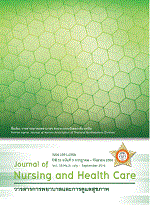ประสิทธิผลของการใช้แนวปฏิบัติในการหย่าเครื่องช่วยหายใจต่อ ความสำเร็จของการหย่าเครื่องช่วยหายใจและระยะเวลาใน การหย่าเครื่องช่วยหายใจในผู้ป่วยวิกฤติที่ใส่เครื่องช่วยหายใจ The Eff ectiveness of Weaning Protocol on Weaning Success and Duration of Mechanical V
คำสำคัญ:
แนวปฏิบัติในการหย่าเครื่องช่วยหายใจ ความสำเร็จของการหย่าเครื่องช่วยหายใจ ระยะเวลาในการหย่า เครื่องช่วยหายใจ weaning protocol, weaning success, duration of mechanical ventilationบทคัดย่อ
การวิจัยครั้งนี้เป็นการวิจัยเชิงเปรียบเทียบ(Comparative study) แบบ retrospective and prospective
before and after intervention study เพื่อศึกษาผลของการใช้แนวปฏิบัติในการหย่าเครื่องช่วยหายใจต่อความ
สำเร็จของการหย่าเครื่องช่วยหายใจและระยะเวลาในการหย่าเครื่องช่วยหายใจ กลุ่มตัวอย่างเลือกแบบเฉพาะเจาะจง
เป็นผู้ป่วยที่ใส่ท่อหลอดลมคอและใช้เครื่องช่วยหายใจ แบ่งเป็น 2 กลุ่ม คือกลุ่มก่อนใช้แนวปฏิบัติ จำนวน 87 ราย
และกลุ่มที่ใช้แนวปฏิบัติจำนวน 87 ราย ซึ่งได้รับการดูแลตามแนวปฏิบัติในการหย่าเครื่องช่วยหายใจ ประกอบด้วย
แนวปฏิบัติการประเมินความพร้อมในระยะก่อนหย่าเครื่องช่วยหายใจ แนวปฏิบัติในการดูแลในระยะหย่าเครื่องช่วย
หายใจและแนวปฏิบัติในการประเมินความพร้อมในการถอดท่อช่วยหายใจ เก็บรวบรวมข้อมูลโดยใช้แบบบันทึก
ข้อมูลพื้นฐานและแบบบันทึกข้อมูลการหย่าเครื่องช่วยหายใจเปรียบเทียบความสำเร็จในการหย่าเครื่องช่วยหายใจ
ระหว่างกลุ่มก่อนและกลุ่มที่ใช้แนวปฏิบัติด้วยสถิติ Chi-square และเปรียบเทียบระยะเวลาหย่าเครื่องช่วยหายใจ
ระหว่างกลุ่มก่อนและกลุ่มที่ใช้แนวปฏิบัติด้วยสถิติ Mann Whitney U-test ผลการวิจัยพบว่า ความสำเร็จในการหย่าเครื่องช่วยหายใจกลุ่มที่ใช้แนวปฏิบัติการพยาบาลสูงกว่ากลุ่มก่อนใช้แนวปฏิบัติการพยาบาลอย่างมีนัยสำคัญทางสถิติ (p=.000) และระยะเวลาในการหย่าเครื่องช่วยหายใจในกลุ่มที่ใช้แนวปฏิบัติตํ่ากว่ากลุ่มก่อนใช้แนวปฏิบัติอย่างมีนัยสำคัญทางสถิติ (p =.000)
The purpose of this Retrospective and Prospective before and after Intervention study aimed to examine the effectiveness of weaning protocol on weaning success and duration of mechanical ventilation in critically ill patients. A purposive sample of 174 patients,87 in retrospective and 87 prospective group,was recruited for thisstudy. The retrospective group received a usual care. The prospective group received the evidence-based weaning protocol comprising; Weaning assessment guideline, Weaning care protocol and extubation assessment guideline. Data were collected by using the biographic and weaning recording
forms. Chi-square test was used to compare the weaning success rates of the 2 groups, Mann Whitney U-test was used to compare the duration of mechanical ventilation of the 2 groups. The fi ndings of this study showed that the rates of weaning success of the prospective group are signifi cantly higher than those of the retrospective group (p = .000). Duration of mechanical ventilation of the prospective group was signifi cantly lower than that of the retrospective group (p = .000)



